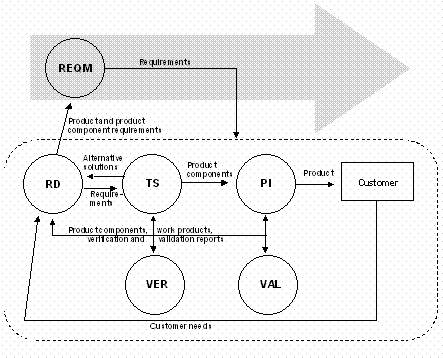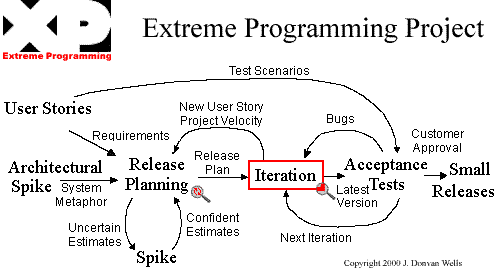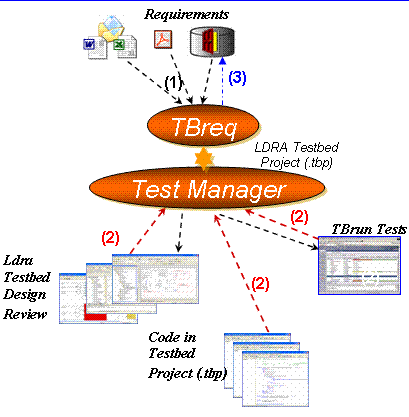Requirements-based testing and its inherent requirements Traceability and verification processes are widely recognized as best practices for promoting enterprise standards, such as Capability Maturity Model Integration (CMMI). CMMI is a process improvement method that provides organizations with key elements of an effective process. It can be used to guide process improvement in a project, department, or organization as a whole. CMMI benefits both critical and non-critical software.
This article refers to the address: http://
As shown in the engineering process area diagram below, Demand Management (REQM) and Requirements Development (RD) are the two main process areas of CMMI.

The technical solution (TS) in the table is to refine the requirements into prototypes or components. The Validation Process Area (VER) ensures that the selected work product meets the specified requirements. The verification process area (VAL) enhances the verification of the product according to the customer's needs. The verification process can be performed in a work environment or a simulated work environment.
Finally, from a programming standard perspective, processes such as Extreme Programming and requirements-based development and testing are indispensable for all development activities. As shown in the figure below, with Extreme Programming, the user's "story" can be prepared by working with the customer before the code is developed, and used as a software prefix for the test scenario.

TBreq Introduction
TBreq consists of LDRA Testbed (including code review, quality review, design review component and code coverage) and TBrun (unit test component), and by integrating with the LDRA toolkit, it provides a unique solution to overcome difficulties and thus test A mapping between specifications, unit test scenarios, test data and code coverage verification and high-level design requirements.
TBreq interfaces directly with requirements management tools (DOORS, ReqPro, Word or Excel) to ensure demand traceability throughout the software lifecycle while ensuring the integrity of demand coverage (see figure below).
In the LDRA toolkit, TBreq generates test specifications and executable test cases directly on demand. Test results are automatically returned to the requirements management tool, providing "two-way" requirements traceability verification.

The role of TBreq is described below: Requirements can be obtained through demand management tools such as DOORS, ReqPro, documentation or spreadsheets. TBreq acts as a gateway between these demand sources and the LDRA Testbed Test Management Dashboard and interfaces directly with the LDRA Testbed project and its underlying project directory.

Requirements can be captured from any source and they can be used (through traceability and validation for Testbed) test management tools. Traceability and requirements mapping are performed directly in Testbed, and information is obtained through design reviews, source files, and TBrun. Verification results and traceability information can be uploaded to the software library.
The TBreq software has two basic types of work processes. The first involves requirements traceability and test validation through low-level requirements and actual build design reviews. Test management tools support mapping between requirements and source code processes or methods. These mapping requirements are acquired sequentially by developers or testers for the purpose of generating test specifications and test validation. Test management tools will also facilitate the automatic generation of test cases in these test specifications. Subsequent releases will support automatic entry of test values ​​from datasheets or specifications. The results of this type of workflow are then mapped back to the requirements source.
This package can also be used for test verification without TBrun. In this workflow scenario, LDRA Testbed is used as the tool source code, which is executed through customer-supplied test harnesses.
TBreq also uses a mechanism called a requirement descriptor thread (or thread) to help achieve fast traceability and verification capabilities. The characteristics of this thread are:
File specification
Source code or frame file name
Demand term
Demand name and number
Demand source document
Demand subject
Demand body
Test configuration
Related test cases/sequences
Coverage level
Test case/sequence verification status
Test Specification
Process or class interface
Test Data
Test management
Project manager name
Developer/Tester Name
Thread type (RV or DV)
Threads are created for all high levels (systems) and all low level (design) requirements. The previous thread type is called a demand verification (RV) thread, and the latter thread type is called a design verification (DV) thread. The thread contains the requirement name and number and the request body (body). Threads also contain mapping information for source code file specifications and related process prototypes (test specifications). The relevant test case mappings are provided by the test configuration and the required coverage level (eg, statement 100%; branch 80%) )
Summary of this article
Software TBreq provides a comprehensive, complete solution for demand traceability and verification. In addition, the TBreq package integrated with the LDRA toolkit is fully compliant with the critical software standards discussed above. Moreover, TBreq provides the process infrastructure required by the standard for the CMMI Level 2 process area (Requirement Management) and the CMMI Level 3 Process Area (Requirement Development).
Substation Transformer,Prefabricated Substation,High Quality Prefabricated Substation,European Type Substation
Hangzhou Qiantang River Electric Group Co., Ltd.(QRE) , https://www.qretransformer.com